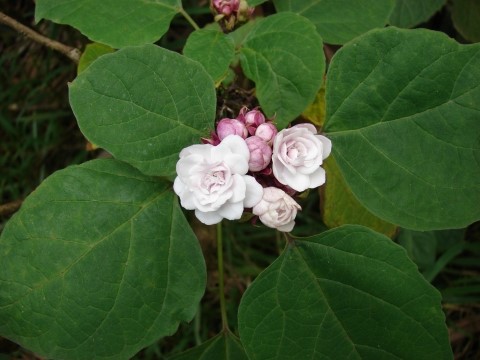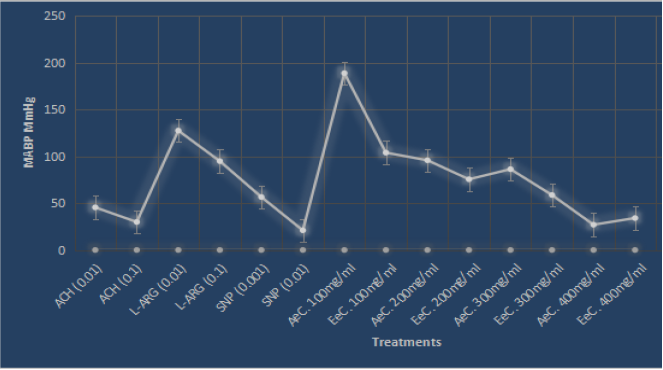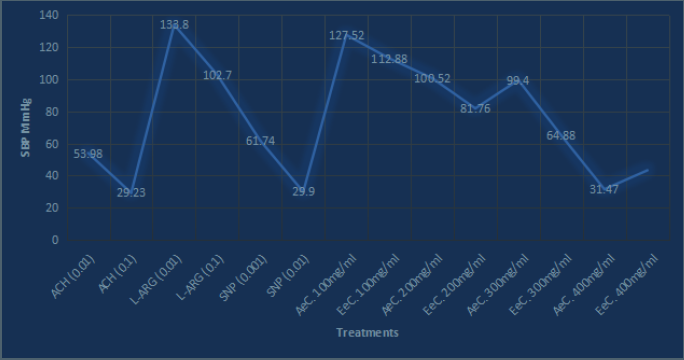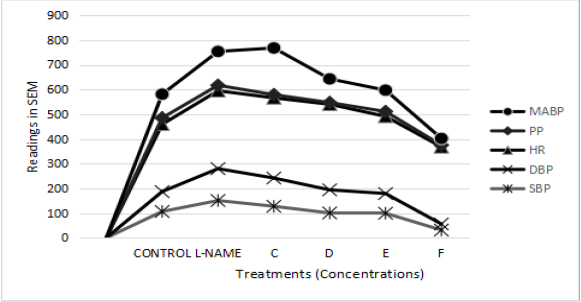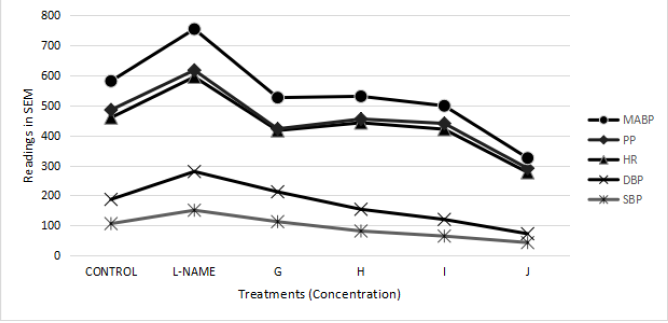Abstract
Background: The rise in the occurrence of hypertension, a non-communicable disease and a major factor for chronic renal failure, cardiovascular disease, and stroke, which most times lead to sudden death is worrisome. Resistant hypertension is more common and may have no symptoms at all for months or years, but then can cause heart attack, stroke, and vision and kidney damage. Prevention and quick management of hypertension is therefore essential in reducing the risk of these debilitating ailments. Aqueous and ethanolic extracts of the leaves of Clerodendrum chinensis (AeC and EeC) are used by local communities of West Africa as medicine for rapid anti-hypertensive actions. We aim to discover the scientific basis for the use of the herb as medicine.
Methods: This work investigates the anti-hypertensive effects of AeC and EeC in L-Arginine Methyl Ester Hydrochloride (L-NAME)- induced hypertensive rats Acetylcholine, L-Arginine and Sodium Nitroprusside were used as standards. All results were expressed as means ± standard error of mean. Differences were considered significant at p<0.05.
Results: Intravenous administration of the extracts caused a significant decrease in the Mean Arterial Blood Pressure (MABP) in a dose-dependent manner. AeC at 100 mg/kg caused a significant decline in blood pressure in a dose-related manner. Likewise, at 100 mg/kg, EeC reduced MABP steadily from 103.9 ± 2.55 to 34.1 ± 0.95mmHg. The two extracts; possess significant anti-hypertensive properties.
Conclusions: Both extracts show significant anti-hypertensive effects and at high doses could lead to hypotension and so should be used with care. Further research is necessary to determine safe dosage forms.
Keywords
Clerodendrum chinensis, Herbal medicine, L-NAME-hypertensive rat and Resistant hypertension
Introduction
Cardiovascular diseases (CVDs) encompass several coronary artery diseases (CAD) like Angina, Myocardial infarction among others [1]. Other CVDs are cardiomyopathy, hypertension, rheumatic heart disease, heart arrhythmia, peripheral artery disease, and venous thrombosis [1]. These diseases are being witnessed in a larger percentage of the population and in younger subjects too. Also, patients have reported a certain resistance of the disease conditions to known drugs.
CVDs are the highest cause of deaths all over the world. WHO, in 2008 reported that more than 17 million people died from CVDs complications that year alone of which more than 3 million of these could have been prevented by changes in diet and lifestyle. Hypertension, the most common CVD also known as high blood pressure, is a medical condition in which the blood pressure in the arteries is persistently elevated [2]. There has been an increase in incidences of hypertension with the proportion of the global burden of disease attributable to hypertension increasing significantly from 4.5% in 2000 to 7% in 2010 [3]. Hypertension leads to complications with considerable morbidity and mortality which is responsible for at least 45% of deaths due to heart disease and 51% of deaths due to stroke [3]. The number of people with uncontrolled hypertension has increased to about 1 billion worldwide in the past 30 years [4]. The prevalence of hypertension cases is increasing worldwide; in both developed and developing worlds and seen more and more frequently in younger patients [5]. Sustained high blood pressure is considered responsible for many serious medical conditions such as arteriosclerosis, heart failure, kidney failure, blindness, and cognitive impairment, and also for many deaths from stroke and heart disease. Systolic, diastolic, and pulse pressure are important predictors of cardiovascular risk [6].
Scientists are reverting to nature for solutions to ailments hence the renewed great interest in plants with antihypertensive compounds used locally but not certified scientifically. Clerodendrum chinensis [Osbeck] Mabb.
Figure 1 (Chinese glory bower, glory tree, Honolulu rose, stick bush) is a species of flowering plant in the genus Clerodendrum. It is placed in the family Lamiaceae, a native to Asian countries of China, Korea, Taiwan, Japan, Vietnam, Western Samoa and American Samoa [7] where it grows commonly as a weed along roadsides and as an ornamental shrub with stout branches. The plant has several synonyms; C. fragrans, C. japonicum etc [8]. The leaves’ tinctures are diuretic [9]. A decoction of the leaves is used in the treatment of blenorrhoea (Chlamydial conjunctivitis) and reputedly a remedy for difficult cases of scabies. Juice from the leaves is an ingredient of herbal bath for children with furuncles [7]. The plant is used for the treatment of rheumatism and ague and as an ingredient of a mixture for treating skin problems [10]. The root extracts are considered antibacterial, and diuretic. It is used in the treatment of abdominal pain, intestinal disease and kidney dysfunctions. It is said to have been used successfully in the treatment of jaundice, lumbago, and hypertension [7]. It is often grown as an ornamental, the double-flowered but sterile form being most commonly cultivated [11].
L-arginine (L-ARG) is an amino acid with lipid peroxidation-lowering effects which may account for its beneficial effect on Systolic Blood Pressure (SBP) and vascular responsiveness [15]. The objectives of this work are to study the anti-hypertensive effects of AeC and EeC and evaluate its safety by acute toxicity of using L-NAME induced hypertensive rats.
Materials and Methods
Reagents
L-NAME (Sigma Aldrich, USA). Heparin, Acetylcholine and Sodium Nitroprusside was obtained from the Department of Physiology, College of Medicine University of Lagos, Nigeria. L-Arginine was obtained from the Department of Pharmacology, College of Medicine University of Lagos, Nigeria.
Plant collection
The leaves of Clerodendrum chinensis were originally from plants collected from Abidjan, Ivory Coast and cultivated in a private garden at Lekki, Lagos State, Nigeria 6°29′36″N 3°43′14″E. Verification of the plant identity was carried out at the Herbarium of the Department of Botany, University of Lagos, Nigeria and plant assigned voucher number FIH 6974.
Extract preparation
Ethanol extract, EeC; leaves were air-dried and ground then extracted with absolute ethanol, using cold maceration. The mixture was filtered and extract concentrated by evaporation, air-dried and stored at 20°C.
Aqueous extract, AeC; leaves were air-dried and pulverized then macerated in distilled boiling water (100oC) and the marc obtained was left to stand for 24 hours and then filtered. The filtrate obtained was concentrated by evaporation at 50°C and the extract stored at 20°C.
Phytochemical analysis
Phytochemical studies were conducted on AeC and EeC for the presence or absence of Alkaloids, Flavonoids, Anthraquinones (free or combined), Tannins, Steroids, Saponins, Terpenoids, and Cardiac glycosides.
Experimental procedure
Male Wistar rats (8-10 weeks, weighing 130-170 g) were used. All animals were housed under constant temperature and exposed to a 12 hr light/12 hr dark cycle and were fed a standard chow diet. Animal protocols were approved by the ethics committee for the care and use of laboratory animals at the University of Lagos, Nigeria. After 1 week of acclimatization, the animals were randomly divided into 5 per group for Aqueous and Ethanolic extracts into the following experimental groups;
A. Control Group received saline water
B. L-NAME only Group: received L-NAME (20 mg/kg)
Aqueous extracts grouping; AeC
C. L-NAME + 100 MG/KG
D. L-NAME + 200 MG/KG
E. L-NAME + 300 MG/KG
F. L-NAME + 400 MG/KG
Ethanolic Extracts grouping; EeC
G. L-NAME + 100 MG/KG
H. L-NAME + 200 MG/KG
I. L-NAME + 300 MG/KG
J. L-NAME + 400 MG/KG
Blood pressure measurement for the duration of experiment was carried out with a power lab (TICE®).
Animals were anaesthetized humanely at the end of the experiments according to established protocols. The extracts and the standard agents were administered twenty minutes (20 mins) after L-NAME administration. Heparin solution was injected in the arterial catheter at intervals to avoid possible blood coagulation. Readings obtained were analyzed using the power lab and recorded. The safety effects of AeC and EeC were studied In-vivo on the systolic blood pressure, diastolic blood pressure and mean arterial blood pressure of rats treated with L-NAME.
Acute toxicity test
A single dose test was carried out for acute toxicity of the extracts. A dozen mice were fasted for 16 hours and then administered 5000 mg/kg AeC and EeC separately. They were observed for 24 to 72 hours for signs of behavioral change and death.
Statistical analysis
Statistical analysis was performed and carried out by student’s t-test using Graph Pad Prism 5.0. All results were expressed as means ± standard error of mean (SEM). Differences were considered significant at p<0.05.
Results and Discussion
Phytochemical analysis showed the presence of flavonoids, alkaloids, steroids, terpenoids, and cardiac glycosides in the leaves of the test plant. The intravenous administration of AeC and EeC to L-NAME induced hypertensive rats caused a significant decrease in systolic blood pressure, diastolic blood pressure and Mean Arterial Blood Pressure (Figures 2-5 and Appendices). Table 1 shows that the control groups were adequate as controls as the saline group did not show any significant increment or decrease in the parameters of importance while the L-NAME control group showed an increase in the parameters. It is well known that L-NAME, administered either acutely by intravenous route or chronically through oral route induce sustained hypertension [16,17]. The genus Clerodendrum is well documented to have beneficial effects on the cardiovascular system of mammals due to its significant flavonoid content [18,19]. Indeed, flavonoids from a great variety of plants have hypotensive and vasorelaxant activities [20,21]. Wang et al., [22] conducted an extensive study of the diverse phytochemicals in aqueous and methanolic fractions of different plant parts and published them with relevant structures.
Figure 2. Effects of Standard drug agents and AeC and EeC on MABP. Key: ACH: Acetylcholine; L-ARG: L-Arginine; SNP: Sodium Nitroprusside (all in Moles); AeC: Aqueous extract; EeC: Ethanol extract.
Figure 3. Effects of Standard drug agents and AeC and EeC on SBP. Key: Standard Agents (P<0.01). ACH: Acetylcholine; L-ARG: L-Arginine; SNP: Sodium Nitroprusside (all in Moles) AeC: Aqueous extract; EeC: Ethanol extract.
Figure 4. Effects of AeC on SBP, DBP, HR, PP and MABP.
Figure 5. Effects of EeC on SBP, DBP, HR, PP and MABP.
| Groups | SYSTOLIC BP (mmHg) |
DIASTOLIC BP (mmHg) |
MEAN ARTERIAL BP (mmHg) |
HEART RATE | PULSE PRESSURE |
|---|---|---|---|---|---|
| Saline Group | 106.47 ± 21.9 | 80.53 ± 33.86 | 95.9 ± 24.1 | 272± 7.9 | 25.89 ± 12.39 |
| L-NAME only Group | 150.9 ± 9.5 | 128.8 ± 8.4 | 136.85 ± 11.8 | 315 ± 0.6 | 22.18 ± 2.81 |
| Values are expressed in Mean ± SEM. L-NAME group = P<0.05 | |||||
AeC at 400 mg/ml appears to be the most effective dosage statistically (Figures 2-5) comparing very favorably with the standards ACH and SNP (Figures 2 and 3). L-NAME, when administered, induces a sustained mean arterial hypertension which persisted for over 30 minutes as observed in the experiments with MABP of 136.85 ± 11.8 mmHg (Table 1). MABP was further elevated on the administration of the lowest dose (100 mg/kg) of the AeC from 136.85 ± 11.8 mmHg to 188.8 ± 0.8 mmHg. There was however a decline as the concentration increases from 95.8 ± 1.2 mmHg to 86.3 ± 0.9 mmHg respectively (Figure 2). The heart rate was also affected (Table 2, Figures 4 and 5).
MABP dropped suddenly after administration of 400 mg/ml to 27± 1.5 mmHg. The immediate fall in blood pressure induced by the doses (100, 200, 300 and 400 mg/ml) of the AeC was followed by a short-lasting effect indicating that the anti-hypertensive effects of the AeC are dose-related.
The speed of the blood pressure drop is accounted for in local usage where the patients reported that they are careful about the number of times in a day they consume the decoction. 100 mg/ml of the EeC reduced MABP to 103.9± 2.55 mmHg. 200 mg/ml, 300 mg/ml, 400 mg/ml reduced MABP to 75.5 mmHg ± 0.75, 58.7 ± 1.5, 34.1 ± 0.95 mmHg respectively (Figure 2).
The effects were more lasting than that of the AeC and are observed to also be dose-related. The result, however, shows that the elevated MABP was reduced more by the EeC when compared to the AeC in the L-NAME induced hypertensive rats. AeC, at 100 mg/ml, 200 mg/ml and 300 mg/ml reduced blood pressure and did not go below 90 mmHg/60 mmHg and can be considered as appropriate doses in reducing high blood pressure. For the EeC, only 100 mg/kg was identified to reduce high blood pressure below 90 mmHg/ 60 mmHg and can be considered appropriate in reducing blood pressure also (Figures 3 and 4).
As in previous studies [17], SNP administration leads to a rapid reduction in ABP (Figure 2) and when compared to both extracts, it can be said that SNP and the plants extracts successfully reduced the blood pressure (Figure 2). The effects of Acetylcholine, when compared to that of the extracts, was better but also shows a significant decrease in blood pressure by the extracts (Figures 2-4). Both extracts showed a significant decrease in blood pressure when compared to the standard agents (Table 2).
Conclusion
This study demonstrated the acute anti-hypertensive properties of the AeC and EeC in Nitric Oxide deficient hypertensive rats. The observed effects could partially be due to the reduction of the peripheral resistance by thwarting the acute inhibitory effect of L-NAME on endothelial Nitric Oxide Synthase. The recorded results authenticate its use in traditional medicine for the treatment of hypertension. Clerodendrum chinensis leaves extract, have shown to exhibit more potent anti-hypertensive properties when compared to known standards. Further studies are however required to check specific mechanisms of action and best and effective dosage forms.
Ethical Approval and Consent to Participate
Not applicable.
Consent for Publication
All the authors have seen the manuscript and agree to the publication.
Competing Interests
The authors declare no conflict of interest.
Funding
This research did not receive any specific grant from funding agencies in the public, commercial, or not-forprofit sectors.
Authors’ Contributions
Odimegwu JI Conceptualized the research, designed the methodology, wrote up the original draft and corrected the final manuscript.
Okanlawon TF worked at Data curation and corrected Manuscript
Obumneme Noel NE carried out laboratory work and contributed to editing and review
Ishola IO supervised the laboratory work and data curation.
Acknowledgment
We are grateful to Prof. Chantal Epie who collected the plants and told us about its actions and also to Mme Rosemary Ossai for cultivating and multiplying the plant for more sample materials for this work.
References
2. Naish J, Syndercombe CD. Medical Sciences (2 ed.). 2014. 562.
3. WHO. Causes of Death 2008 Data Sources and Methods. Geneva. Accessed on July 9th, 2016.
4. Danaei G, Finucane M, Lin J, Singh G, Paciorek C, Cowan M, et al. Global Burden of Metabolic Risk Factors of Chronic Diseases Collaborating Group (Blood Pressure). Lancet. 2011;377(9765):568-77.
5. D’agostino RB, Vasan RS, Pencina MJ, Wolf PA, Cobain M, Massaro JM, et al. General cardiovascular risk profile for use in primary care. Circulation. 2008 Feb 12;117(6):743-53.
6. Benetos A, Thomas F, Bean K, Gautier S, Smulyan H, Guize L. Prognostic value of systolic and diastolic blood pressure in treated hypertensive men. Archives of Internal Medicine. 2002 Mar 11;162(5):577-81.
7. PROSEA (Plant Resources of Southeast Asia). 2012. http://proseanet.org
8. Roskov Y, Ower G, Orrel T, Nicolson D, Bailly N, Kirk PM, et al., (eds). Species 2000 and ITIS Catalogue of Life, 2019 Annual Checklist. 2019.
9. van Duong N. Medicinal plants of Vietnam, Cambodia and Laos. Publisher; Mekong Printing; Vietnam (Printers). 1993.
10. DeFilipps RA, Maina SL, Crepin J. Medicinal Plants of the Guianas. Department of Botany, National Museum of Natural History, Smithsonian Institution, Washington, D.C. 20013-7012. 2004.
11. Valkenburg Van JLCH, Bunyapraphatsara N. Medicinal and poisonous plants. Plant Resources of South-East Asia no. 12 (2). Backhuys Publishers, Leiden, the Netherlands. 2001.
12. Ribeiro MO, Antunes E, De Nucci G, Lovisolo SM, Zatz R. Chronic inhibition of nitric oxide synthesis. A new model of arterial hypertension. Hypertension. 1992 Sep;20(3):298-303.
13. Razny U, Kiec-Wilk B, Wator L, Polus A, Dyduch G, Solnica B, et al. Increased nitric oxide availability attenuates high fat diet metabolic alterations and gene expression associated with insulin resistance. Cardiovascular Diabetology. 2011 Dec;10(1):1-4.
14. Bunbupha S, Prachaney P, Kukongviriyapan U, Kukongviriyapan V, Welbat JU, Pakdeechote P. Asiatic acid alleviates cardiovascular remodelling in rats with L-NAME-induced hypertension. Clinical and Experimental Pharmacology and Physiology. 2015 Nov;42(11):1189-97.
15. Carrón R, Sanz E, Puebla P, Martín ML, San Román L, Guerrero MF. Mechanisms of relaxation induced by flavonoid ayanin in isolated aorta rings from Wistar rats. Colombia Médica. 2010 Mar;41(1):10-6.
16. Nyadjeu P, Nguelefack-Mbuyo EP, Atsamo AD, Nguelefack TB, Dongmo AB, Kamanyi A. Acute and chronic antihypertensive effects of Cinnamomum zeylanicum stem bark methanol extract in L-NAME-induced hypertensive rats. BMC Complementary and Alternative medicine. 2013 Dec;13(1):27.
17. Chaswal M, Das S, Prasad J, Katyal A, Fahim M. Cardiac autonomic function in acutely nitric oxide deficient hypertensive rats: role of the sympathetic nervous system and oxidative stress. Canadian Journal of Physiology and Pharmacology. 2011 Dec;89(12):865-74.
18. Chan EC, Pannangpetch P, Woodman OL. Relaxation to flavones and flavonols in rat isolated thoracic aorta: mechanism of action and structure-activity relationships. Journal of Cardiovascular Pharmacology. 2000 Feb 1;35(2):326-33.
19. Arif-Ullah K, Anwarul H. Pharmacodynamic evaluation of Terminalia bellerica for its antihypertensive effect. Journal of Food and Drug Analysis. 2008;16(3):6- 14.
20. Aduragbenro D, Yeside O, Adeolu A, Olanrewaju J, Ayotunde SA, Olumayokun O, et al. Blood pressure lowering effect of Terminalia bellerica seed extract on normotensive rats. Record of Natural Products. 2009;3(2):82-89.
21. Carrón R, Sanz E, Puebla P, Martín ML, San Román L, Guerrero MF. Mechanisms of relaxation induced by flavonoid ayanin in isolated aorta rings from Wistar rats. Colombia Médica. 2010 Mar;41(1):10-6.
22. Wang JH, Luan F, He XD, Wang Y, Li MX. Traditional uses and pharmacological properties of Clerodendrum phytochemicals. Journal of traditional and complementary medicine. 2018 Jan 1;8(1):24-38.
23. Species 2000: Naturalis, Leiden, the Netherlands. Tropical Plants Database, Ken Fern. tropical. The fern.

